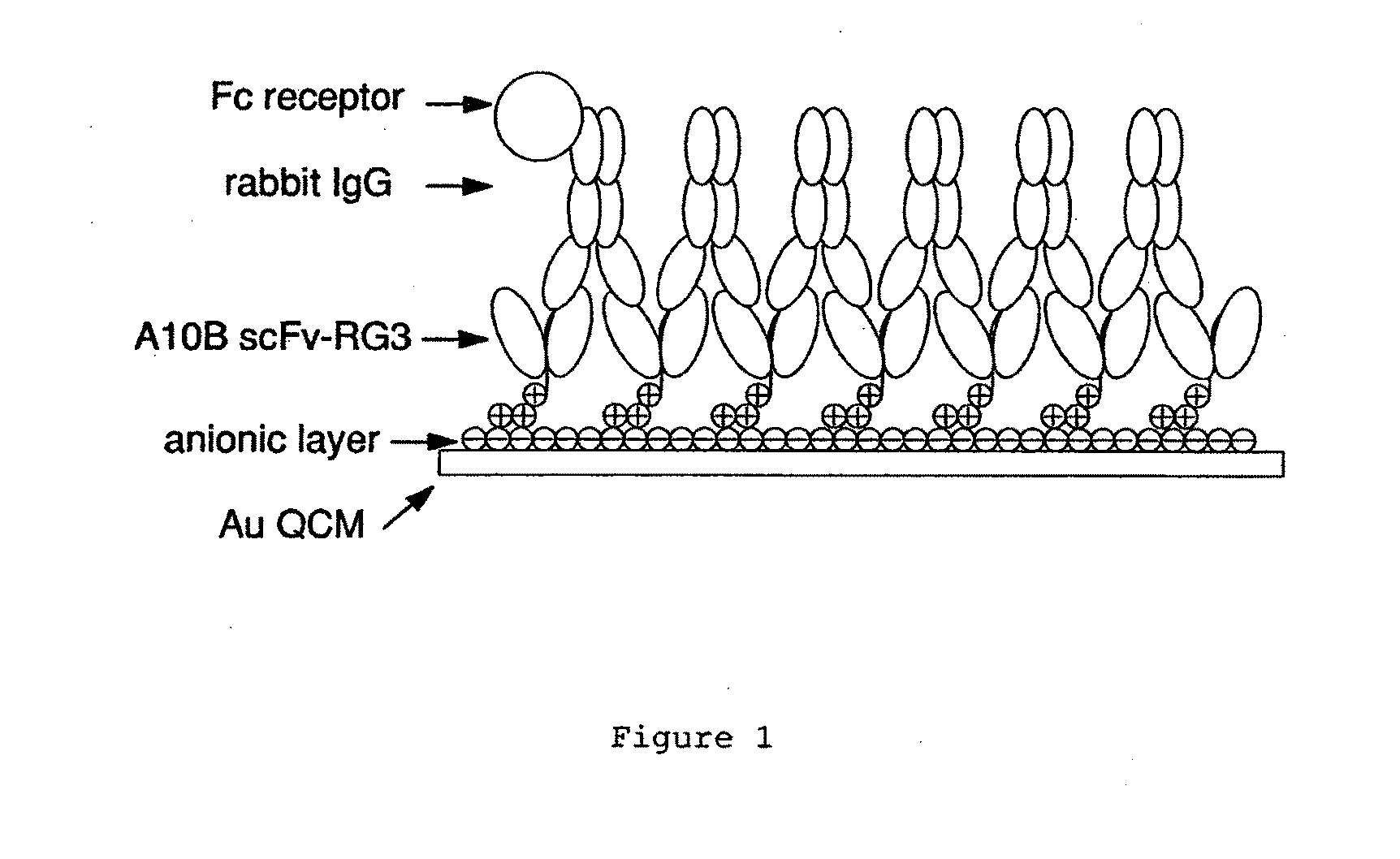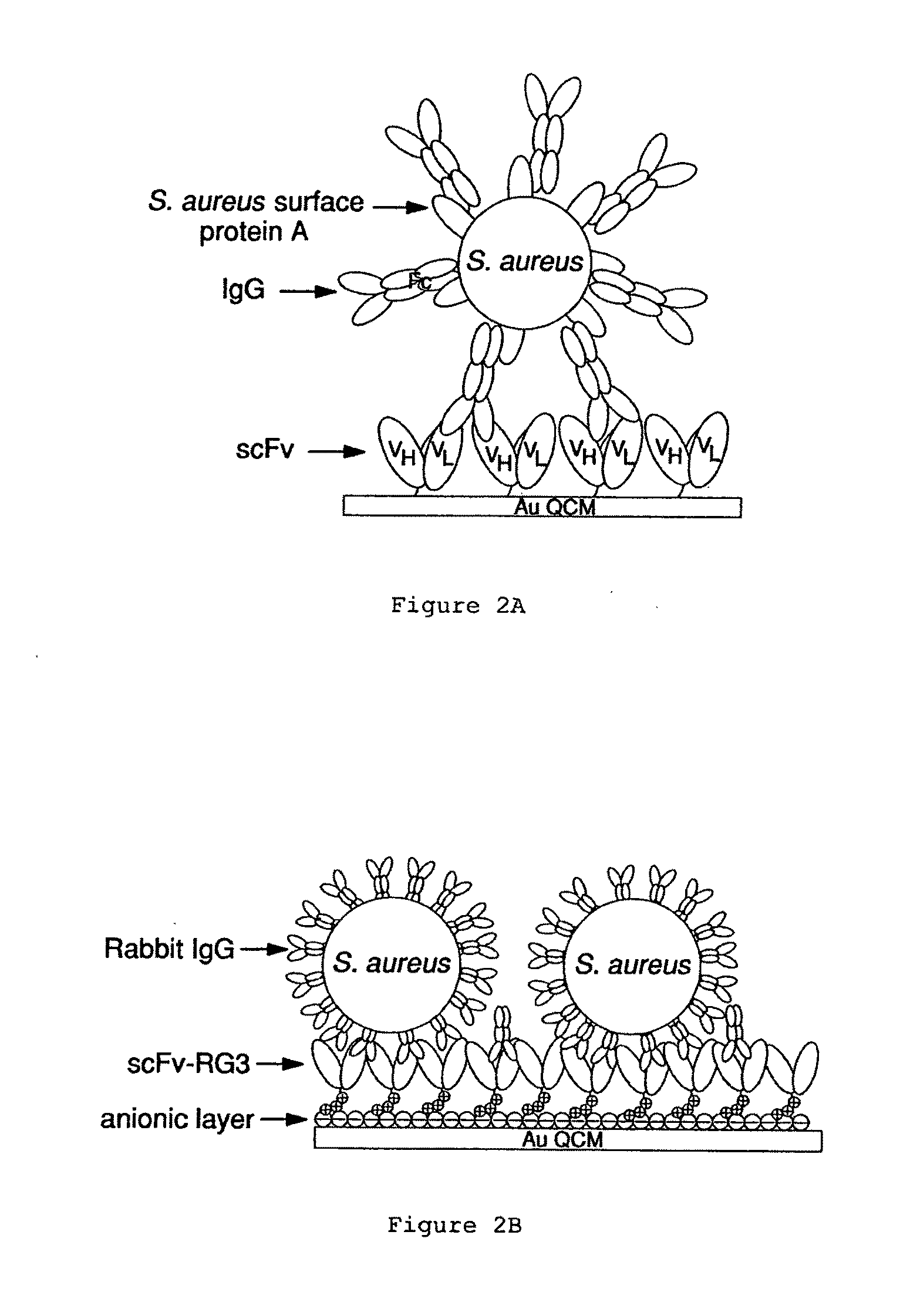Immunosensors: scFv-linker design for surface immobilization
a single-chain fragment, surface immobilization technology, applied in the field of single-chain fragment variables (scfv) antibody molecules, can solve the problems of long circulating half-life, inability to initiate immunoresponse, and complete loss of fv function
- Summary
- Abstract
- Description
- Claims
- Application Information
AI Technical Summary
Benefits of technology
Problems solved by technology
Method used
Image
Examples
example 1
[0052]In this example, an A10B scFv RG linker with positively charged RG linkers were successfully used to couple to a negatively charged gold surface. This coupling method has shown the best performance when compared with other linker designs including cysteine and histidine. This approach has broad applicability since a negatively charged linker, such as a linker with arginine amino acid residues, could be coupled to positively charged gold template. The scFv immobilization was based on pre-formed self assemble monolayer (SAM) templates incorporated with various properties. These properties, such as negative charge, positive charge, and hydrogen bonding, can further anchor the scFvs with a linker that is designed to match those interactions on the SAM template to form orientated scFv layers. The immobilized scFvs can be used for protein recognition for clinical and environmental applications, and also can be used to detect bacteria.
[0053]Chemicals and materials: Rabbit IgG (cat#1-...
example 2
[0074]This example is a surface plasmon resonance (SPR) study of 2-mercaptoethaol as a template in A10B scFv-YG immobilization.
[0075]Motivation: We have created an innovative immobilization method that is easy to operate, efficient, less costing and reliable in constructing biosensors for non-labeled immunoassay for understanding antibody and antigen interaction. Traditional immunoassays like ELISA are very reliable but is also a time- and cost-consuming process. For example, two antibodies that are specific for different sites on the same antigen are needed. It is not always easy to find such proper antibody pair for the assay. On the contrary, non-labeled immunosensors will do assays in a simple one step fashion. The sensing element, most likely the antibody, is immobilized on the surface of a transducer. When the antibody interacts with the antigen, mechanical or optical properties of the transducer are also changed. Such change is recorded and analyzed to provide information of ...
example 3
[0097]This example illustrates how scFv QCM can be used to detect bacteria. We have demonstrated that the scFv biosensor system can be used to provide a platform immobilization strategy to build rigid IgG Fc receptor layers. Just as important, the ability of immunoglobulins to react with other molecules at sites located outside the antigen-combining site, related to the effector functions of antibodies, are the most important part of the immune response including from such well-known reactions as the activation of the complement cascade and the activation or the inhibition of cells after binding with the Fc receptors to transportation of immunoglobulins through cell membranes. Shown in FIG. 1, monomeric scFv allows uniform 2:1 binding with rabbit IgG CH1 region, this results a highly oriented IgG Fc portion pointing toward solution phase for the detection of Fc receptors. This feasibility was proved by detection of Protein A, an Fc receptor on the cell wall of Staphylococcus aureus ...
PUM
 Login to View More
Login to View More Abstract
Description
Claims
Application Information
 Login to View More
Login to View More - R&D
- Intellectual Property
- Life Sciences
- Materials
- Tech Scout
- Unparalleled Data Quality
- Higher Quality Content
- 60% Fewer Hallucinations
Browse by: Latest US Patents, China's latest patents, Technical Efficacy Thesaurus, Application Domain, Technology Topic, Popular Technical Reports.
© 2025 PatSnap. All rights reserved.Legal|Privacy policy|Modern Slavery Act Transparency Statement|Sitemap|About US| Contact US: help@patsnap.com



